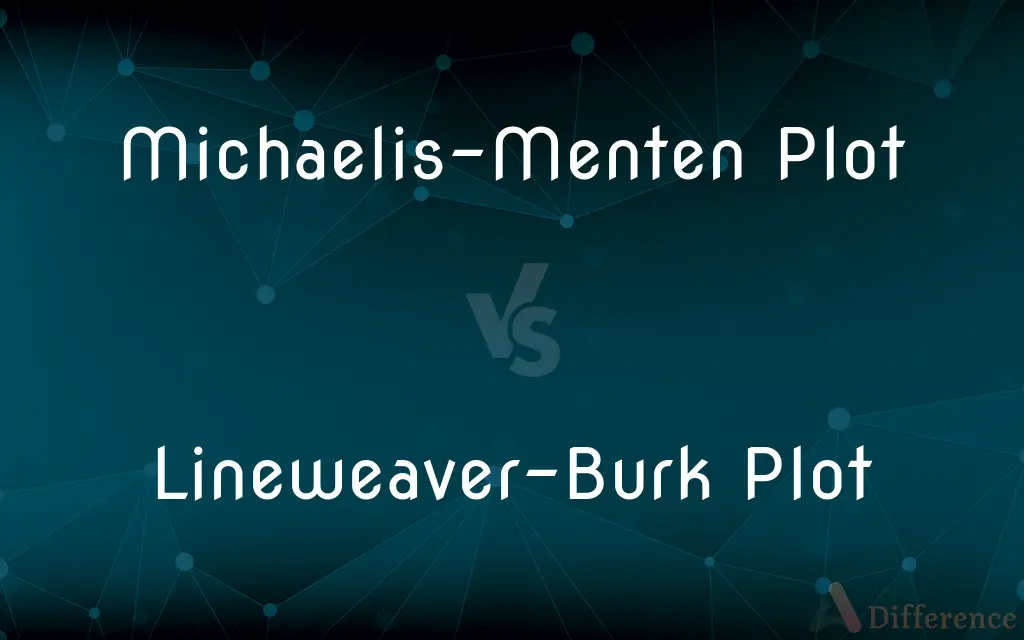Michaelis-Menten Plot vs. Lineweaver-Burk Plot — What's the Difference?
By Fiza Rafique & Maham Liaqat — Published on February 20, 2024
The Michaelis-Menten plot shows how reaction rate varies with substrate concentration, while the Lineweaver-Burk plot linearizes this relationship to determine kinetic constants.

Difference Between Michaelis-Menten Plot and Lineweaver-Burk Plot
Table of Contents
ADVERTISEMENT
Key Differences
The Michaelis-Menten plot is foundational in enzyme kinetics, offering a graphical representation of how the rate of an enzyme-catalyzed reaction changes with varying substrate concentrations. It illustrates that as substrate concentration increases, the reaction rate also increases until it reaches a maximum velocity (Vmax), beyond which additional substrate does not further increase the rate. This plot is hyperbolic and is used to estimate the maximum rate of an enzymatic reaction (Vmax) and the substrate concentration at which the reaction rate is half of Vmax (Km), indicative of enzyme affinity for its substrate.
The Lineweaver-Burk plot, also known as the double reciprocal plot, linearizes the Michaelis-Menten equation by plotting the reciprocal of the reaction rate (1/V) against the reciprocal of substrate concentration (1/[S]). This linear transformation makes it easier to accurately determine Vmax and Km from the y-intercept and slope, respectively. The Lineweaver-Burk plot is particularly useful for identifying enzyme inhibition mechanisms and comparing the kinetic parameters of different enzymes under various conditions.
While the Michaelis-Menten plot is straightforward and intuitive, showing the saturation kinetics of enzymes directly, the Lineweaver-Burk plot provides a means to extract kinetic parameters with higher precision from the linear relationship. However, the Lineweaver-Burk plot can amplify experimental errors, especially at low substrate concentrations, and may not always be the best choice for analyzing enzyme kinetics.
Both plots serve crucial roles in enzyme kinetics studies, with the Michaelis-Menten plot offering an immediate visual representation of enzyme behavior across substrate concentrations, and the Lineweaver-Burk plot providing a more analytical tool for extracting kinetic constants and understanding enzyme inhibition.
Comparison Chart
Graph Shape
Hyperbolic
Linear
ADVERTISEMENT
Purpose
Visualize enzyme kinetics directly
Facilitate calculation of kinetic constants
Axis
Reaction rate (V) vs. Substrate concentration ([S])
Inverse reaction rate (1/V) vs. Inverse substrate concentration (1/[S])
Parameter Estimation
Qualitative estimation of Vmax and Km
Precise calculation of Vmax and Km
Usefulness
Intuitive understanding of enzyme behavior
Analyzing enzyme inhibition and comparing enzymes
Compare with Definitions
Michaelis-Menten Plot
Used for initial visualization of enzyme kinetics.
We used a Michaelis-Menten plot to observe the reaction's initial kinetics.
Lineweaver-Burk Plot
Useful for identifying enzyme inhibition.
Different slopes on the Lineweaver-Burk plot indicate the type of enzyme inhibition.
Michaelis-Menten Plot
Illustrates enzyme saturation kinetics.
As substrate concentration increases, the curve in the Michaelis-Menten plot approaches Vmax.
Lineweaver-Burk Plot
Facilitates calculation of Vmax and Km.
From the Lineweaver-Burk plot, we accurately determined the enzyme's Vmax and Km.
Michaelis-Menten Plot
Indicates enzyme affinity through Km value.
The Km value from the Michaelis-Menten plot suggests a high affinity between enzyme and substrate.
Lineweaver-Burk Plot
Plots 1/V against 1/[S] for enzyme kinetics.
The Lineweaver-Burk plot simplifies comparing kinetic data between enzymes.
Michaelis-Menten Plot
Hyperbolic curve representation.
The hyperbolic nature of the Michaelis-Menten plot indicates enzyme efficiency.
Lineweaver-Burk Plot
Amplifies experimental errors at low substrate concentrations.
Care must be taken when interpreting the Lineweaver-Burk plot due to potential error amplification.
Michaelis-Menten Plot
Graphs reaction rate versus substrate concentration.
The Michaelis-Menten plot showed the enzyme's Vmax at high substrate levels.
Lineweaver-Burk Plot
Linear plot of reciprocal values of reaction rate and substrate concentration.
The Lineweaver-Burk plot linearizes enzyme kinetics for clearer analysis.
Common Curiosities
What does a Michaelis-Menten plot show?
It shows how reaction rate varies with substrate concentration in enzyme-catalyzed reactions.
Why use a Lineweaver-Burk plot?
It allows for precise calculation of kinetic constants from a linear relationship.
What is the main disadvantage of the Lineweaver-Burk plot?
It can amplify experimental errors, especially in data from low substrate concentrations.
How does substrate concentration affect these plots?
It's directly plotted in the Michaelis-Menten and inversely in the Lineweaver-Burk.
What does Km represent in these plots?
The substrate concentration at half Vmax, indicative of enzyme affinity for its substrate.
Can these plots be used for non-enzyme reactions?
They are specifically designed for enzyme-catalyzed reactions.
How does enzyme inhibition appear on a Lineweaver-Burk plot?
It changes the slope and/or y-intercept, depending on the inhibition type.
Can both plots be used for all enzyme reactions?
Yes, but the choice depends on the analysis need and data quality.
Why might one prefer the Michaelis-Menten plot?
For its direct and intuitive visualization of enzyme kinetics.
How do competitive inhibitors appear on these plots?
They increase Km without affecting Vmax on a Michaelis-Menten plot and change the slope on a Lineweaver-Burk plot.
What information does the slope of a Lineweaver-Burk plot provide?
It gives the Km/Vmax ratio, offering insights into enzyme efficiency and affinity.
How do you determine Vmax from these plots?
In a Michaelis-Menten plot, it's the asymptote; in a Lineweaver-Burk plot, it's calculated from the y-intercept.
How do non-competitive inhibitors affect these plots?
They decrease Vmax without changing Km on a Michaelis-Menten plot and alter the y-intercept on a Lineweaver-Burk plot.
Why is the Lineweaver-Burk plot considered linear?
Because it plots the reciprocals of concentration and rate, converting the hyperbolic Michaelis-Menten equation into a straight line.
Which plot is better for initial kinetic studies?
The Michaelis-Menten plot, for its straightforward representation of enzyme behavior.
Share Your Discovery

Previous Comparison
HPLC vs. GC
Next Comparison
PSP 2000 vs. PSP 3000Author Spotlight
Written by
Fiza RafiqueFiza Rafique is a skilled content writer at AskDifference.com, where she meticulously refines and enhances written pieces. Drawing from her vast editorial expertise, Fiza ensures clarity, accuracy, and precision in every article. Passionate about language, she continually seeks to elevate the quality of content for readers worldwide.
Co-written by
Maham Liaqat













































